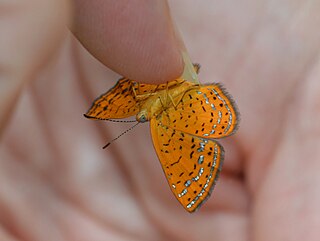
Cirsium is a genus of perennial and biennial flowering plants in the Asteraceae, one of several genera known commonly as thistles. They are more precisely known as plume thistles. These differ from other thistle genera in having feathered hairs to their achenes. The other genera have a pappus of simple unbranched hairs.

Cirsium vulgare, the spear thistle, bull thistle, or common thistle, is a species of the Asteraceae genus Cirsium, native throughout most of Europe, Western Asia, and northwestern Africa. It is also naturalised in North America, Africa, and Australia and is an invasive weed in some areas. It is the national flower of Scotland.

Cirsium arvense is a perennial species of flowering plant in the family Asteraceae, native throughout Europe and western Asia, northern Africa and widely introduced elsewhere. The standard English name in its native area is creeping thistle. It is also commonly known as Canada thistle and field thistle.

Cirsium edule, the edible thistle or Indian thistle, is a species of thistle in the genus Cirsium, native to western North America from southeastern Alaska south through British Columbia to Washington and Oregon, and locally inland to Idaho. It is a larval host to the mylitta crescent and the painted lady.

Cirsium eriophorum, the woolly thistle, is a herbaceous biennial species of flowering plant in the genus Cirsium of the family Asteraceae. It is widespread across much of Europe. It is a large biennial plant with sharp spines on the tips of the leaves, and long, woolly hairs on much of the foliage. The flower heads are large and nearly spherical, with spines on the outside and many purple disc florets but no ray florets.

Cirsium occidentale, with the common name cobweb thistle or cobwebby thistle, is a North American species of thistle in the family Asteraceae.

Cirsium discolor, the field thistle, is a North American species of plants in the tribe Cardueae within the family Asteraceae. It is native to thirty-three states in the United States as well four Canadian provinces. It occurs across much of eastern and central Canada as well as eastern and central United States. It has been found from New Brunswick west to Saskatchewan and south as far as Texas and Georgia.

Calephelis muticum, the swamp metalmark, is a butterfly species in the family Riodinidae.

Almutaster is a North American genus of plants in the family Asteraceae containing the single species Almutaster pauciflorus, which is known by the common name alkali marsh aster. It is native to Canada, the Western United States, and northern and central Mexico. The genus is named for botanist Almut Gitter Jones.
Cirsium crassicaule is a species of thistle known by the common name slough thistle. It is endemic to the San Joaquin Valley of California, where it is known primarily from freshwater wetlands. It has been found in only a few locations in Kern, Kings, and San Joaquin Counties.

Cirsium scariosum is a species of thistle known by the common names meadow thistle, elk thistle and dwarf thistle. It is native to much of western North America from Alberta and British Columbia, south to Baja California. There are also isolated populations on the Canadian Atlantic Coast, on the Mingan Archipelago in Québec, where it is called the Mingan thistle.

Cirsium parryi, or Parry's thistle, is a species of North American flowering plants in the family Asteraceae. It is native to the southwestern United States, where it has been found in Colorado, Arizona, and New Mexico.
Cirsium pumilum var. hillii is a type of thistle endemic to North America. The common name for this plant is Hill's thistle.

Cirsium altissimum is a North American species of plants in the tribe Cardueae within the family Asteraceae. Common names are tall thistle or roadside thistle. The species is native to the eastern and Central United States.

Cirsium horridulum, called bristly thistle, purple thistle, or yellow thistle is a North American species of plants in the tribe Cardueae within the family Asteraceae. It is an annual or biennial. The species is native to the eastern and southern United States from New England to Florida, Texas, and Oklahoma as well as to Mexico, Belize, Guatemala, Honduras, and the Bahamas.

Cirsium repandum is a North American species of plants in the tribe Cardueae within the family Asteraceae. Common names include sand-hill thistle and coastal-plain thistle. The species is native to the south-eastern United States, the coastal plain in Virginia, Georgia, and the Carolinas.

Lactuca graminifolia, the grassleaf lettuce is a North American species of wild lettuce. It grows in Mexico, Central America, Hispaniola, and the southern United States from Arizona to Florida, Virginia and the Carolinas.

Symphyotrichum racemosum is a species of flowering plant native to parts of the United States and introduced in Canada. It is known as smooth white oldfield aster and small white aster. It is a perennial, herbaceous plant in the family Asteraceae. It is a late-summer and fall blooming flower.

















